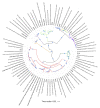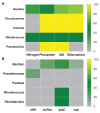Multiple Plant Growth-Promotion Traits in Endophytic Bacteria Retrieved in the Vegetative Stage From Passionflower
- PMID: 33537051
- PMCID: PMC7847900
- DOI: 10.3389/fpls.2020.621740
Multiple Plant Growth-Promotion Traits in Endophytic Bacteria Retrieved in the Vegetative Stage From Passionflower
Abstract
Bacteria exhibiting beneficial traits like increasing the bioavailability of essential nutrients and modulating hormone levels in plants are known as plant growth promoting (PGP) bacteria. The occurrence of this specific group of bacteria in the endophytic environment may reflect the decisive role they play in a particular condition. This study aimed to determine the taxonomical diversity of the culturable bacterial endophytes, isolated in the vegetative stage of passionflower (Passiflora incarnata), and assess its potential to promote plant growth by phenotypic and genotypic approaches. The sequencing and phylogenetic analysis of the 16S rRNA gene allowed us to classify 58 bacterial endophytes into nine genera. Bacillus (70.7%) was the most dominant genus, followed by Pseudomonas (8.6%) and Pantoea (6.9%). A few isolates belonged to Rhodococcus and Paenibacillus, whereas the genera Lysinibacillus, Microvirga, Xanthomonas, and Leclercia were represented by only one isolate. The strains were tested for nitrogen fixation, phosphate solubilization, indole-acetic-acid synthesis, and siderophore production. Moreover, PGP related genes (nifH, ipdC, asb, and AcPho) were detected by PCR-based screening. Most of the isolates (94.8%) displayed a potential for at least one of the PGP traits tested by biochemical assays or PCR-based screening. Nine strains were selected based on results from both approaches and were evaluated for boosting the Cape gooseberry (Physalis peruviana) germination and growth. All tested isolates improved germination in vitro, and the majority (78%) increased growth parameters in vivo. The results suggested that most of culturable bacteria inhabiting P. incarnata in the vegetative stage could be used as probiotics for agricultural systems. Besides, their occurrence may be associated with specific physiological needs typical of this development stage.
Keywords: Cape gooseberry; PGP bacteria; PGP genes; Passiflora incarnata; inoculant.
Copyright © 2021 Cueva-Yesquén, Goulart, Attili de Angelis, Nopper Alves and Fantinatti-Garboggini.
Conflict of interest statement
The authors declare that the research was conducted in the absence of any commercial or financial relationships that could be construed as a potential conflict of interest.
Figures


 ); detection of the nifH gene(
); detection of the nifH gene( ); formation of halo on a NBRIP medium (
); formation of halo on a NBRIP medium ( );detection of the AcPho gene (
);detection of the AcPho gene ( ); IAA-like compound production (
); IAA-like compound production ( ); detection of the ipdC gene (
); detection of the ipdC gene ( ); formation of orange halo on a CAS Agar (
); formation of orange halo on a CAS Agar ( ); detection of the asb gene (
); detection of the asb gene ( ); and unspecific amplification of a gene involved iron metabolism (tatA;
); and unspecific amplification of a gene involved iron metabolism (tatA;  ).
).



Similar articles
-
Culturable endophytic bacteria of Camellia species endowed with plant growth promoting characteristics.J Appl Microbiol. 2019 Sep;127(3):825-844. doi: 10.1111/jam.14356. Epub 2019 Jul 10. J Appl Microbiol. 2019. PMID: 31216598
-
Abundant and diverse endophytic bacteria associated with medicinal plant Arctium lappa L. and their potential for host plant growth promoting.Antonie Van Leeuwenhoek. 2022 Dec;115(12):1405-1420. doi: 10.1007/s10482-022-01785-x. Epub 2022 Oct 25. Antonie Van Leeuwenhoek. 2022. PMID: 36284037
-
Characterizing endophytic competence and plant growth promotion of bacterial endophytes inhabiting the seed endosphere of Rice.BMC Microbiol. 2017 Oct 26;17(1):209. doi: 10.1186/s12866-017-1117-0. BMC Microbiol. 2017. PMID: 29073903 Free PMC article.
-
Growth stage and tissue specific colonization of endophytic bacteria having plant growth promoting traits in hybrid and composite maize (Zea mays L.).Microbiol Res. 2018 Sep;214:101-113. doi: 10.1016/j.micres.2018.05.016. Epub 2018 May 26. Microbiol Res. 2018. PMID: 30031472
-
Passionflower.2020 Mar 28. LiverTox: Clinical and Research Information on Drug-Induced Liver Injury [Internet]. Bethesda (MD): National Institute of Diabetes and Digestive and Kidney Diseases; 2012–. 2020 Mar 28. LiverTox: Clinical and Research Information on Drug-Induced Liver Injury [Internet]. Bethesda (MD): National Institute of Diabetes and Digestive and Kidney Diseases; 2012–. PMID: 31643352 Free Books & Documents. Review.
Cited by
-
Isolation of endophytes from Dioscorea nipponica Makino for stimulating diosgenin production and plant growth.Plant Cell Rep. 2024 Mar 12;43(4):95. doi: 10.1007/s00299-024-03164-4. Plant Cell Rep. 2024. PMID: 38472393
-
Pseudomonas flavocrustae sp. nov., an endophyte with plant growth promoting traits isolated from Passiflora incarnata.Sci Rep. 2024 Jun 21;14(1):14285. doi: 10.1038/s41598-024-64349-1. Sci Rep. 2024. PMID: 38902258 Free PMC article.
-
Effects of Rhizosphere Bacteria on Strawberry Plants (Fragaria × ananassa Duch.) under Water Deficit.Int J Mol Sci. 2022 Sep 9;23(18):10449. doi: 10.3390/ijms231810449. Int J Mol Sci. 2022. PMID: 36142361 Free PMC article.
-
Pseudomonas aeruginosa and Bacillus cereus Isolated from Brazilian Cerrado Soil Act as Phosphate-Solubilizing Bacteria.Curr Microbiol. 2023 Mar 23;80(5):146. doi: 10.1007/s00284-023-03260-w. Curr Microbiol. 2023. PMID: 36952131
-
Isolation and evaluation of growth-promoting endophytic bacteria from Zanthoxylum dissitum Hemsl.Physiol Mol Biol Plants. 2025 Feb;31(2):299-310. doi: 10.1007/s12298-025-01552-y. Epub 2025 Jan 24. Physiol Mol Biol Plants. 2025. PMID: 40070537
References
-
- Andreolli M., Lampis S., Zapparoli G., Angelini E., Vallini G. (2016). Diversity of bacterial endophytes in 3- and 15-year-old grapevines of Vitis vinifera cv. Corvina and their potential for plant growth promotion and phytopathogen control. Microbiol. Res. 183, 42–52. 10.1016/j.micres.2015.11.009, PMID: - DOI - PubMed
-
- Ansary W. R., Prince F. R. K., Haque E., Sultana F., West H. M., Rahman M., et al. . (2018). Endophytic Bacillus spp. from medicinal plants inhibit mycelial growth of Sclerotinia sclerotiorum and promote plant growth. Z. Naturforsch. C, J. Biosci. 73, 247–256. 10.1515/znc-2018-0002, PMID: - DOI - PubMed
-
- Arunachalam T., Chavan K. M. (2018). Dry matter accumulation and nutrient uptake patterns of onion seed crop. J. Plant Nutr. 41, 1879–1889. 10.1080/01904167.2018.1476538 - DOI
-
- Ash C., Farrow J. A., Dorsch M., Stackebrandt E., Collins M. D. (1991). Comparative analysis of Bacillus anthracis, Bacillus cereus, and related species on the basis of reverse transcriptase sequencing of 16S rRNA. Int. J. Syst. Bacteriol. 41, 343–346. 10.1099/00207713-41-3-343, PMID: - DOI - PubMed
LinkOut - more resources
Full Text Sources
Other Literature Sources
Miscellaneous

